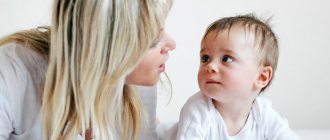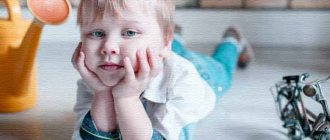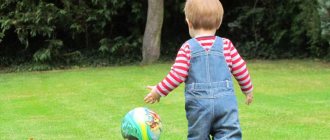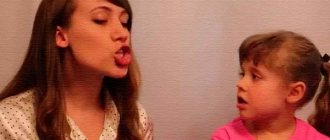What should a child say at two years old?
Imperfections in the pronunciation side of a child’s speech at this age are a natural phenomenon. He still pronounces most sounds incorrectly, misses sounds when pronouncing words and individual syllables when pronouncing polysyllabic words, and softens consonants. The voice of some children is still quiet and weak, they pronounce even simple words indistinctly, and this is also a variant of the norm. Two-year-olds have a small vocabulary, they use words denoting well-known objects and toys, and can still use lightweight words like “bye-bye” instead of “sleep”, “yum-yum” instead of “eat”.
However, a child is already able to speak at 2 years old in short phrases of 2-4 words, and can ask a question, for example, “What is this?” A two-year-old child with speech development within normal limits, on his own initiative, addresses peers and familiar adults, using the active vocabulary that is available to him. And not so little is available to him - at the border between the second and third years, the vocabulary is at least 50-100 words, and by 2.5 years this number triples.
If you work with the baby purposefully, telling him the signs of objects and actions that children and adults perform, then the active dictionary contains not only nouns, but also adjectives, verbs, and adverbs.
Despite a fairly capacious vocabulary, the words in a sentence are often inconsistent and phrases are constructed incorrectly. The inability to form correct grammatical forms is the norm at this age. For example, if a child at 2 years old says this: at home - at home, after washing, a beautiful jacket - a beautiful jacket, a rug - a rug, then this is normal.
The baby not only asks questions himself, he is able to answer simple questions from an adult, that is, he distinguishes interrogative intonation. In addition, he can follow simple verbal instructions consisting of 2-3 steps: “first take the spoon, and then take it to the table.” Since the organs of articulation are not strong enough to clearly pronounce sounds, 2-year-old children still pronounce the sounds incorrectly: s, s, z, z, ts, sh, zh, h, sch, l, r.
Factors influencing the development of speech in a child
How actively, correctly and at what age the baby begins to speak depends on certain factors:
- the degree of myelination of nerve fibers, that is, the covering of nerves with a special sheath - myelin;
- features of the development of sensory organs;
- activity of the speech environment;
- the child’s mental health status;
- level of need to use speech.
As can be seen from the list above, genetic and social factors play a role in speech development. They complement each other. Even with a low rate of myelination of nerves and low development of the cortex, a favorable society and proper exercises will help to get the baby talking.
I would like to pay special attention to the point about the activity of the speech environment. If a mother wants her child to start talking as early as possible, she needs to constantly talk to him. There is no need to give a gadget and play meaningless videos on it. You should devote maximum of your time to children.
Possible causes of speech delay
If a child is 2 years old and cannot speak, relying on the advice of friends, you cannot expect a sudden jump in speech activity. “With us, too, he was silent and silent, and then he started talking!” “His dad also didn’t speak for a long time, and nothing, everything is fine...” Even if the speech delay is due to a genetic predisposition, it is worth contacting a specialist for a preliminary assessment of the norm and pathology. Up to 3 years, correction of speech disorders does not require large time and material costs; after this period, correcting something is much more difficult.
You should pay special attention to a speech delay of 2 years if the following factors were present:
- birth injury;
- asphyxia during childbirth;
- neuroinfections, frequent colds, flu suffered in early childhood;
- traumatic brain injury in a child;
- discrepancy with the mother's Rh factor;
- the child has received little attention and there is a lack of communication.
A speech delay of 2 years can occur in overprotected children, when they have no reason to use speech, as well as in children growing up in families with low-speaking parents.
If a child at 2 years old does not speak due to a poor speech environment, the delay in speech development can be compensated for independently in a short time. If speech underdevelopment was caused by functional disorders of the central nervous system, speech correction together with parents should be carried out by specialists - a neuropathologist, a neuropsychiatrist, a speech therapist, a speech pathologist.
Indicators of speech development in children
When selecting special exercises, parents, teachers, and health care professionals should rely on indicators of children’s speech development. They were developed back in the 70s, but have not lost their relevance. The most important things are presented in the table.
| Indicators | Ages from 2 years to 2 years and 6 months | Ages from 2 years and 6 months to 3 years |
| Speech understanding | The child understands not only what is happening at the moment. You can talk with him about past and future events. | The child begins to understand the meaning of the situations described by the adult, even if they did not take place in his life |
| Imitating someone else's speech | Children repeat whole phrases and poems after adults | Children quickly repeat the poems and songs they hear |
| Dictionary | Unfamiliar phrases are easily woven into a child’s vocabulary. Questions arise: “When?”, “Where?”, “Why?” | Vocabulary increases sharply. By the end of the second year it is about 1500 words |
| Grammar | Sentences are getting more complex | Participial phrases appear, but they are not always grammatically correct |
| Connected speech | The child begins to communicate with peers. He describes all his actions, situations | Describes something previously seen or done in separate phrases. If asked, can retell a fairy tale fragmentarily |
| Intonation | Speech is colored by emotions |
In kindergarten, according to the level of speech development, children are divided into three subgroups:
- Subgroup 1 – the child answers the adult’s questions and tries to tell him.
- Subgroup 2 – children do not answer questions independently, but repeat after their peers. They rarely initiate speech.
- Subgroup 3 - children are almost always silent, they can speak individual letters and unrelated words.
This division can also be applied at home. This will allow you to select exercises appropriate to the child’s level. If a child speaks practically or not at all in the second year of life, he can be classified in subgroup 3.
Any exercises are selected together with a specialist after making an accurate diagnosis.
How to determine delayed speech development at 2 years
If parents have a suspicion that their child’s speech does not correspond to the norm for this age, it is better to entrust the assessment of the child’s speech to a specialist. First of all, you need to consult a pediatric neurologist, then visit a speech therapist and speech pathologist.
Reasons for contacting a specialist:
- the child does not address adults and, if necessary, limits himself to gestures or facial expressions;
- he speaks one language that he understands, and he does not care that he is not understood;
- the baby’s speech lags behind several periods of speech development, for example, there are only babbling words and onomatopoeia;
- a child cannot fulfill an adult’s request if it is not accompanied by gestures;
- the baby has not developed fine motor skills, he is awkward, takes small objects with several fingers, not two;
- there was speech and then it disappeared;
- The child names different objects with one babbling word.
You should not ignore such symptoms. A much more productive tactic is to start classes with a specialist or get recommendations from him for independent training. There is a fundamentally incorrect opinion that you need to go to a speech therapist when the child is 4.5–5 years old. This is partly correct only for the correction of phonetic underdevelopment of speech, when by the age of five individual sounds can appear independently and do not have to be corrected. If a child does not speak at 2 years of age, the disorder has a different development mechanism, and completely different correction techniques are used here.
How to stimulate the speech development of a two-year-old baby
In order for the baby’s active speech to develop, you need to create communication situations for him, not prevent his desires, but give him the opportunity to express a request, try to get him to talk. It is important to satisfy his interest in objects, actions and accumulation of impressions. You can play hide and seek with toys, offering to call the hidden rooster, cat, or bunny. When buying a new toy, you need to look at it, name the parts, show how they play with it, naming their actions.
The video shows what to do if a child speaks poorly at two years old, what games to play with children to teach them to communicate:
It is very useful to talk during a walk about what new and attractive things the child sees around him. It is important not only to show and name objects, but also to talk about their purpose. “Scissors cut paper”, “There is soap in the soap dish.” Pay attention to the shape and size of objects, their color.
Read more often to your child fairy tales, poems, and jokes that are understandable to him, accompanying the reading by showing bright and colorful illustrations, chat with him on any occasion. Let the child finish the endings of the lines and repeat the phrases of the heroes of fairy tales. Constant attention to the speech of a two-year-old child will help overcome speech delays, if any.
Now you know what to do when your baby barely speaks at the age of two. If you have any questions, ask our children's speech therapist.
How to develop the speech abilities of two-year-olds
Even if a child is recommended to have classes with a speech pathologist (sometimes expensive), at the age of two they are short-term. The baby does this activity for 10-15 minutes. Exercises are organized only in the form of a game and can be successfully performed by parents independently. It must be remembered that the baby will require increased activity from adults. It is necessary to pronounce each of your actions, ask, call for a conversation, answer questions, motivate, pronounce words together.
Exercises are carried out only with positive emotions, as in this case there will be results. In order to consolidate a skill, repeated repetitions are necessary. In games, be sure to use visual material, bright toys, pictures that will interest the baby’s attention. It would also be a good idea to take into account the child’s experience of understanding the world around him, not to utter incomprehensible words, and not to construct long sentences. Shorten words by pointing to objects. Material for games is selected according to the principle from simple to complex. Classes should include a variety of activities aimed at developing specific skills.
For the slightest achievements of the baby, hug, kiss, show emotions, since a child, even at this age, is already able to establish cause-and-effect relationships. If mom is happy, then we need to “do it again”! The baby learns about the world by imitating adults, and therefore in the game you should interest your silent child as much as possible.
Choosing games
The main task of an adult is to teach the child to imitate. The main principle of learning is gradualism and slowness.
- “Let’s do exercises.” The point of the game is that the adult comes up with exercises that the baby would repeat and perform with him: clapping, jumping, steps, swinging his arms and legs. At first, the movements are performed separately, then the material becomes more complex and additional ones are added, for example, clapping your hands and walking in place.
- Fun logorhythmics. These are musical games for developing the rhythm and feeling of music, as well as the use of simple words for movements: “Clap-clap, stomp-stomp.” An adult must pronounce all actions to the music. Such activities have a beneficial effect on the child’s speech and motor development and allow them to quickly achieve a positive effect and emotional response, especially if they are performed together with their beloved mother.
- "Games with objects." For example, we bathe the Katya doll. Mom pronounces each action: “Let's take the doll, undress her, and then put her in the bath. Let’s pour some lukewarm water so that the doll will be pleased...” We define the process as much as possible, and the necessary attributes for the game, such as a bathtub and water, will help make the process interesting and captivating the child’s attention. Your baby will definitely begin to imitate actions, and subsequently try to pronounce words with you.
- Nursery rhyme games. It’s not for nothing that our great-grandmothers knew all kinds of jokes filled with folklore. Such sayings are easy to remember and repeat, and are most understandable to children with their simple rhythms. They are used in the development of speech of two-year-old children. “Okay-okay”, “Guli-guli” and much more.
- Games with small objects. Training fine motor skills directly related to the speech areas of the cerebral cortex. Invite your little one to tear together a sheet of colored paper into small pieces, and then assemble some kind of composition from them, being sure to praise your little helper. During joint activities, pronounce each action, for example, “drip-drip, it began to rain, whew-fuh, the snow flew, rust-shur, the wind blew.”
- You can build a finger pool from various safe small fillers, and, under close supervision, “bathe” small fingers, talking through what is happening.
- Get your little one used to reading children's books together. To begin with, you need books without text, with bright, large, colorful pictures; music books help best here. When showing pictures, we describe what we have drawn in our own words, pay attention to the details, stop, examine, and pronounce. Then you can use illustrated books with short poetic summaries written in capital letters so that the baby gets used to the fact that books can be read and listened to.
- "Sounds of animals and objects." You can use animal model toys, or you can use painting material. "Who is this? Hen! What does the chicken say? Ko-ko-ko." "What is this? Airplane! How does the plane sound? Oooh." Such exercises significantly develop the child’s articulation; you can blow like a breeze, “Sh-sh-sh,” and ring like a mosquito, “S-s-s.” Not only the articulatory apparatus develops, but also phonemic hearing, which is responsible for distinguishing speech and non-speech sounds. We focus the child's attention on the fact that individual sounds can be pronounced.
- Development of general motor skills. Coordination of body movements. Playing with a ball, big and small, will help. They also contribute to the positive dynamics of playing fitball. There is a set of exercises aimed at developing the baby’s physical abilities. And, as you know, psychophysical development works in conjunction with psycho-speech development.
When working with non-speaking children, it is necessary to understand that the speech environment must be properly organized and motivation for joint activities must be created. You need to be prepared for the fact that everything will not work out right away; it will take some time to find contact with the baby. In some cases, working together with a neurologist will help achieve positive results. Probably, two years for parents of a non-speaking child is absolutely no reason to panic, but in any case, joint work on speech development will not be superfluous, but will only help the baby form a correct and timely understanding of the world around him.











